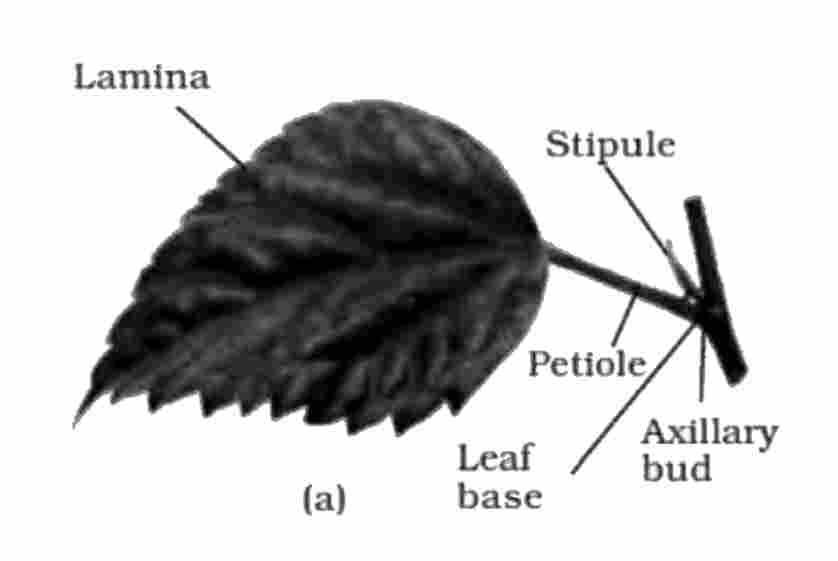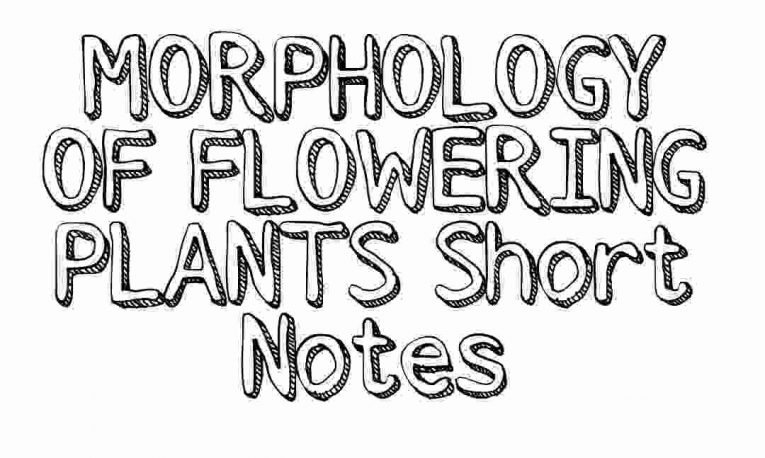
Morphology Of flowering plants notes for neet exam chapter 4 short notes for online education.
The Root
🔸In Dicotyledons, elongation of radicle forms the primary roots which bears lateral roots of the several orders called secondary roots, tertiary roots etc.
🔸Primary roots along with the lateral roots forms Tap root system. Mustard, Gram etc.
🔸In monocotyledons, primary root is replaced by the large number of roots at its base of stem to constitute Fibrous root system. Wheat, rice etc.
🔸Roots that arise from other parts of the plant beside radicle are called the adventitious roots. Example- Grass, Banyan tree, Maize etc.
Regions of Roots-

Modification of roots– The Roots are modified for storage, nitrogen fixation, aeration and support.
🔸Tap root of carrot (conical tap root), radish (fusiform tap root), turnip (napiform tap root) and adventitious
root of sweet potato get swollen to the store food.
🔸The Prop root of Banyan and Stilt root of maize and sugarcane have supporting the root coming out from lower node
of stems.
🔸In Rhizophora, Pneumatophores help to get oxygen for respiration as it grows in the swampy areas.
The Stem
🔸It develops from the Plumule of embryo.
🔸Stem bears nodes and internodes. The region of stem at where leaves are born called nodes and portion between two nodes are called internodes.
Modification of stems-
🔸Underground stem modifications act as the organ of perennation in unfavorable conditions.
Types are as follows:
Sucker: Mint, Chrysanthemum
Rhizome: Ginger
Corm: Colocasia
Tuber: Potato
Bulb: Onions, Garlic
🔸The Stem tendril help plants to climb as in cucumber, pumpkins, and grapes.
🔸Axillary buds of the stem may modify into woody, straight and pointed thorns as in Citrus and Bougainvillea.
The Leaf –

🔸Leaf is green, dissimilar exogenous lateral flattened outgrowth which is borne on the node of the stem or its branches.
🔸Leaves originate from the shoot apical meristem and are arranged in an acropetal order.
🔸A typical leaf consists of three parts- Leaf base, Petiole and Lamina.
🔸Leaf is attached with the stem by Leaf Base which may bear two small leaf like structure called stipule.
🔸 The Middle prominent vein is called mid vein. (Morphology Of flowering plants notes for neet)
🔸 Arrangement of vein and veinlets in lamina is called venation.

Types of Leaves
(a) Simple Leaves
(b) Compound leaves: Pinnately compound leaves and Palmately compound leaves
🔸The pattern of arrangement of the leaves on the stem or branch is called Phyllotaxy.
🔸In alternate type of the phyllotaxy single leaf arise at from each node as in China rose.
🔸In opposite type of phyllotaxy a pair of the leaves arise from each node opposite to each other as in the Guava.
🔸If more than two leaves arise at a node and form a whorl is called whorled type of phyllotaxy as in the Alastonia.
Inflorescence
🔸The arrangement of the flowers on the floral axis is termed as inflorescence. Two main types of inflorescence are
racemose and cymose. (Morphology Of flowering plants notes for neet)
The flower
🔸A typical flower has four whorls arranged on a swollen end of the stalk or pedicel called thalamus. They are Calyx, Corolla, Androecium and Gynoecium.
🔸When flower can be divided into two equal radial halves in any radii passing through center the symmetry of the
flower is called actinomorphic
🔸When the flower can be divided into two similar parts only in one vertical plane it is zygomorphic
🔸Floral appendages are in multiple of 3,4 or 5 they are called trimerous, tetramerous and pentamerous
respectively. Flower with reduced small leaf at the base of the pedicel are called bracteates and without it ebracteate.
🔸Based on the position of ovary with respect to the other floral part on thalamus flowers are of following types:
(a). Hypogynous flower
(b). Perigynous flowers
(c). Epigynous flowers
Calyx is the outermost whorls of the flower ; its members are called sepals.
It may be gamosepalous (sepals united) or polysepalous (sepals free).
Corolla consists of petals, they may be gamopetalous or polypetalous.
🔸The mode of arrangement of sepals or petals in floral bud with respect to other members of same whorl is called aestivation.
🔸Types are: Valvate, Twisted, Imbricate, and Vaxillary aestivation. (Morphology Of flowering plants notes for neet)
The Androecium
🔸Androecium represent the male reproductive parts of flower, consists of stamens. Each stamen consists of
filament and anther.The Sterile stamen is called Stemenode.
🔸When stamens are attached with the petals it is called epipetalous (Brinjal).
🔸Stamen may be free (polyandrous) or may be united in one bundle (monoadelphous), two bundles (diadelphous), or more than two (polyadelphous).
The Gynoecium
🔸Female reproductive part of the flower consists of one or more carpels. Each of the carpel is made up of stigma style and ovary.
🔸When more than one carpel is present, it may be free (apocarpous) as in lotus and rose or fused together
(syncarpous) as in the mustard and tomato.
Placentation
🔸The arrangement of ovules within the ovary is called placentation.
Types are:
a) Marginal (pea)
b) Axle (china rose)
c) Parietal (mustard)
d) Free central (dianthes)
e) Basal (sunflower)
The fruit
Mature and ripened ovary developed after fertilization is fruit. If a fruit is formed without fertilization of the ovary it is called parthenocarpic fruit.
🔸Fruit consists of the seeds and pericarp. Thick and fleshy pericarp is three layered called epicarp, mesocarp and endocarp. (Morphology Of flowering plants notes for neet)
The Seed
🔸Dicotyledonous Seed is made up of a seed coat and an embryo. An Embryo is made up of the embryonal axis, radicle
and cotyledons.
🔸Seed coat has two layers outer testa and inner tegmen. Hilum is scar through which the seed is attached to the ovary. Small pore above to the hilum is called micropyle.
🔸In monocotyledonous seed, outer covering of endosperm separate the embryo by the protienous layer called
aleurone layer.
🔸Single cotyledon is called as scutellum which having a short axis bearing Plumule and radicle. (Morphology Of flowering plants notes for neet)
🔸The Plumule and radicle are closed inside sheaths called as coleoptile and coleorhizae respectively.





 155 out of 200 questions were directly asked from these notes in NEET 2024
155 out of 200 questions were directly asked from these notes in NEET 2024
